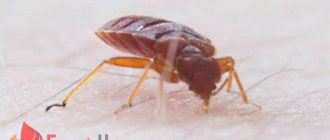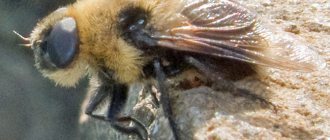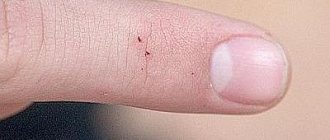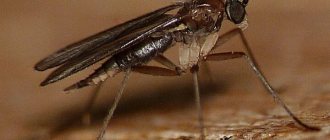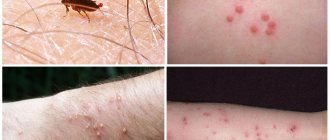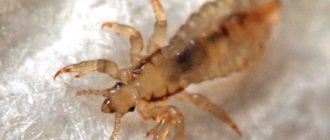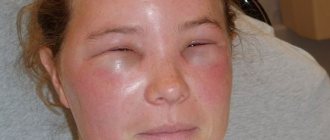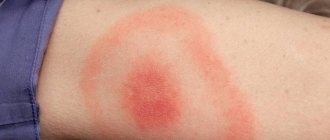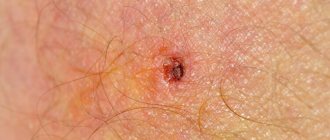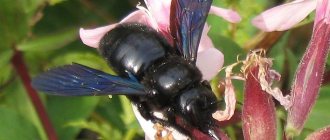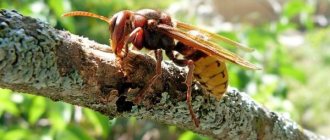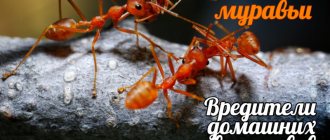In this article we will look at how to deal with ant bites.
Ants are a class of arthropods that are considered the most evolutionarily advanced among the insect family. They live on all continents, with the exception of harsh and cold areas, since at low temperatures the ant hibernates. An ant bite can cause serious health problems because they secrete toxic enzymes. But only some species pose such a danger. What and where dangerous ants live, as well as instructions with recommendations in case of an ant bite will be given in this article.
Which ant bites are dangerous to humans?
Ants are unique and highly organized animals. Only they have complex social groups. Moreover, they have a division of labor and even have a system of self-organization - ants form castes of females, males and labor. There are more than 13 thousand species of such insects; only about 300 species live in Russia.
Therefore, ant bites can be different and have distinctive symptoms. It is worth considering dangerous and common species in order to arm yourself with the necessary knowledge.
Important! There are no poisonous inhabitants on the territory of the Russian Federation. But do not forget that, like any wild insect, an ant can become a carrier of infections and the cause of some ailments.
- The black garden ant is the most famous species. By the way, they often settle in houses. The size of such ants is from 4.5 to 5.5 mm, but females can grow up to 11 mm. The color is black or dark brown, respectively. Often you can see villi on the body. They are the ones who make mounds as houses.
- The house or pharaoh ant is a resident of apartments and houses. Especially, he loves to eat crumbs and sugar. Reaches a maximum of 3 mm, color – brown. Their poison is not dangerous to humans, but they spread various infections throughout your home, as they often crawl into the trash can or garbage chute.
- The forest red ant lives exclusively in forests or gardens. Among other representatives, its dimensions are the largest - 7-11 mm. The characteristic color is red-brown, while males are black with reddish paws. This species is distinguished by large anthills, and a family of up to 1 million individuals can live in it.
Black ant
Symptoms from their bites:
The house ant bites very rarely. Only as a protection. The bites themselves are not painful and do not cause any special reactions. Black ants already bite harder, much like a mosquito. But red ants will cause the greatest discomfort.
- The bite site becomes red, slightly swollen and itchy terribly. Do not scratch the bitten area under any circumstances! The most common area of attack by such animals is the limbs. But they move quite quickly throughout the human body, so they can also attack in the pelvic or back area.
- The sore spot is also often accompanied by a slight increase in temperature and the appearance of a rash. When biting, the insect releases formic acid. It is not dangerous to humans, but if it bites mucous membranes or gets into the eyes, the risk of complications increases.
- As a rule, all symptoms disappear after 2-4 days.
Symptoms of the most dangerous ant bites. None of the representatives live in Russia.
- Bulldog Ant . Undistinguished and inconspicuous ants seem so only at first glance. No, they differ significantly from domestic ants, but we are talking about comparison with their relatives. They are large in size - up to 3 cm with a typical but bright ant color - brown, black, red or orange (it all depends on the subspecies). Habitat: Australia. But the poison of such an insect is considered the most dangerous for humans. This ant not only bites painfully, but also causes severe allergic reactions in almost everyone (due to the complex and unusual active composition of the poison).
Bulldog Ant
- In Tasmania, more deaths have been recorded from this insect than from spiders, snakes and even sharks combined. Approximately 3% of patients bitten experienced anaphylactic shock.
- It is very difficult to guess a person’s reaction, and therefore it is almost impossible to predict it. The bite of such an ant, or rather severe allergic reactions after it, can be fatal.
Bullet Ant
- In addition to the terrible pain, the bite site also swells and becomes paralyzed. Blackening of the bitten areas is also observed.
- The general condition of the body deteriorates significantly. Chills, weakness and headache are possible.
- A person can die from massive bites of such ants.
Fire ants
- The ants themselves are quite small, 3-6 mm, with a discreet reddish-brown color. And, as you can see, the ant received its name not for its color, but for the strength of its bite. It is equivalent to the painful sensations after an open fire.
- But the worst thing is poison. For people with allergies, it can cause death.
- The bite site becomes very swollen, which leads to the formation of tumors. Accompanied by severe itching and burning.
- Not only people suffer from them, but also domestic animals and wildlife.
yellow ant
- At the site of the bite there is severe swelling, itching and pain.
- People can develop unpredictable allergic reactions, especially those who are prone to it.
- They are also distinguished by powerful jaws that are larger than the size of their heads. They need such a structure to obtain food, which often exceeds several times the size of the animal itself. This is also what causes painful bites.
Soldier
- Their danger to humans is slightly exaggerated. Yes, they are like marauders destroying everything in their path, but they will not attack a person unnecessarily. But also take into account the fact that they only move in colonies, so they will all attack together.
- The bite may be accompanied by itching, redness and swelling, but no deaths have been reported. Allergic reactions may occur.
- Often the cause of danger may be that nomads carry certain types of ticks with their colonies. And the latter are already causing harm to people and animals.
Prevention and precautionary measures
If a person has a tendency to allergies and is going into the forest, it is recommended to prepare a special anaphylactic package with syringes, antihistamines, adrenaline, and a tourniquet. Having such a package in the event of a severe allergic reaction can save a life.
- When relaxing in nature, look for resting places that are located at a considerable distance from anthills.
- Choose an open area.
- Place all picnic foods in closed containers, especially sweets.
- Dress properly, arms and legs must be protected.
- Avoid using creams and perfumes with floral scents.
It is worth recalling that ants living in Russia do not pose a danger. And even if they bite, an allergic reaction most likely will not occur. An exception may be people with hypersensitivity to substances present in the secretions of ants. However, even in this case, negative symptoms will only appear in the form of mild urticaria.
Ants are the creatures that have the largest number of species. In nature, there are more than 500 families of these creatures. They can be found in any area except cold continents and islands.
The ant has a gnawing type oral apparatus, which includes one lip and paired upper jaws. In some insect species, the chewing edge is serrated.
Most often, an allergy to ants occurs due to formic acid coming into contact with the skin. Most insect species have a poisonous gland in the abdominal part, which is surrounded by a strong muscular sac. When in danger, the ant bites and bends its body forward. At the same time, its muscles contract and secrete the secretion of the gland. Ant venom is a very dangerous substance for some insects.
A child was bitten by an ant: what to do?
If your child is bitten by a “harmless” ant, then it does not pose any particular danger. The main thing is to clean the wound, eliminate pain and itching.
- First of all, remove the baby from the ants' habitat. Check to see if there are any other insects on your body, as they can even get under your clothes.
- The bite site should be washed under cool running water. If possible, then let the baby swim or lie in a warm bath. Don't forget to use soap.
- Treat the bite with an antiseptic. Alcohol, peroxide or cologne will do. This will help eliminate itching and relieve redness.
- Do not let your child scratch the bitten area!
Child bitten by an ant
- Apply to the sore spot for 10-15 minutes. ice or any cold compress. This will help relieve swelling.
- It won't hurt to apply aloe juice or tea tree oil to the bitten area. They will help eliminate symptoms, alleviate the condition and additionally disinfect the sore spot. You can also treat with soda or saline solution.
- Be sure to monitor your baby throughout the day, as their skin is thinner and more delicate than that of an adult. Therefore, the reaction can be stronger and faster.
- If any allergic reactions occur, give your baby antihistamines. For example, Claritin or Zyrtex.
Important! If the baby’s condition does not improve or he is an allergy sufferer, be sure to go to the hospital. This also applies to cases when the baby was bitten by an ant in the mouth or was swallowed.
Folk remedies
It happens that you don’t have the necessary medication on hand to treat bites. Then folk methods come to the rescue:
- Toothpaste has a cooling effect. Apply it to the bite site, and then the itching will go away.
- Echinacea tincture relieves pain and itching well.
- Water along with ammonia works well against ant bites. They should be diluted in a 1:1 ratio.
- Rub the bite area with a cut piece of onion.
- Milk lotion with ice effectively eliminates redness and itching.
- Baking soda is an excellent option for ant bites.
In addition to all of the above, there are simpler options for treating ant bites:
- Raw potatoes.
- Aloe juice.
- Plantain leaf.
- Parsley juice.
Please note that you should not self-medicate if you are not completely sure that your allergy will not manifest itself.
If you delay going to the doctor too long, the situation can change dramatically and then death is possible.
Ant bite: symptoms, what it looks like, what could be the consequences?
As a rule, ant bites do not pose a serious threat to human life or health. If you haven’t been vacationing in some exotic place at this moment.
- Although an allergic reaction rarely occurs from forest, garden or house ants, allergy sufferers may experience: nausea
- itching all over the body
- hives - small red blisters all over the body. Sometimes they can connect with each other
- Quincke's edema is localized in the areas of the lips, eyes and living tissue. And in the area of the larynx it can pose a threat to life
- Strong headache
- rapid heartbeat and shortness of breath
- lowering blood pressure
- in rare cases, chills are even observed
Is an ant bite dangerous?
- Human eyes are at great risk. No, the ant does not bite in this place. But formic acid, which is shot by an insect at a distance of as much as 30 m, can easily get into the eyes. And this can lead to a retinal burn.
- The situation also worsens if a person is attacked by many insects. In this case, severe swelling or even anaphylactic shock is observed.
- Sometimes the bite site can become filled with a pus-like substance, and scratching can lead to infection. Or scratching can cause scars.
- Ants, like any wild animals, are carriers of infections. Again, scratching the affected area will only aggravate the situation, thereby provoking the formation of inflammatory processes. But that's not all, ants can be carriers of: salmonellosis
- dysentery
- helminthiasis
- diphtheria
- cholera
- typhoid fever
Danger of an allergic reaction
Allergy to bites is manifested not only by pathological processes on the skin. The consequences of ant bites are especially dangerous if you had to survive an attack by several dozen insects.
When an ant bites, it injects poison, which spreads throughout the body and causes a defensive response. If the dose of poison is high, a change in well-being is noted. After an ant bite, the following is observed:
- headache;
- dizziness;
- increased sweating;
- temperature increase;
- decreased blood pressure;
- difficulty breathing;
- swelling near the bitten area.
The most dangerous consequence of an insect attack is swelling of the larynx. If medical care is not provided in a timely manner, a person risks dying.
If you have an allergic reaction, ant bites go away more slowly. For several days the bite site is very itchy, there is redness, and a thickening appears. With numerous scratches, there is a risk of infection. Then suppuration and ulcers form at the site of the bite. This situation often occurs if an ant bites a child.
Ant bites on humans: how to treat, what to apply, how to get rid of itching?
Treatment consists mainly of disinfecting the wound and relieving itching, swelling and redness. Even if the action took place in nature, it wouldn’t hurt to use at least a damp cloth.
- The bite site should be washed with soap and water.
- After that, apply ice or a cold compress.
- And be sure to treat with an antiseptic. It is best to use alcohol.
- For severe itching or redness, use a pharmaceutical ant repellent. This could be Fenistil Gel, Advantan, Vitaon or Gold Star.
- For allergy sufferers, antihistamines should be used. 1 tablet is enough for mild cases. These can be any products that are available without a prescription - Suprastin, Fenistil or Tavegil.
Bite Remedy
- In severe cases, a doctor's consultation is required. Most often, Diphenhydramine is prescribed and a course of steroidal anti-inflammatory drugs is carried out.
Folk remedies:
- A paste of water and soda will help relieve itching. This will also disinfect the bite site.
- Regular table vinegar works well. You can simply wipe the bite area with it or use a compress of soda and vinegar.
- Vinegar can be replaced with lemon juice or just a slice of lemon.
- Cold milk will relieve severe itching.
- Toothpaste, which should be rubbed on the sore area, will help relieve itching and pain. It's better to take mint.
- Echinacea can be wiped over the affected area and even taken orally. This will reduce the likelihood of allergies.
Folk remedies
- Activated charcoal helps not only with stomach upsets. Crush the tablet, add a drop of water and apply the resulting slurry, wrapping the area with film.
- Our grandmothers used onion juice, but this remedy has not lost its effect to this day.
- Aloe juice can truly be called a universal remedy, since it can help in this situation too. Moreover, the healing of the wound will take place much faster. You just need to take fresh juice.
Reviews
Anoint with corvalol or calendula tincture. Give an antihistamine (Fenistil, Zyrtec, Zodak). I also heard that you can apply activir to the bite site. soaked coal in water.
Sources
- https://StopKlopam.com/ukusy-muravev-foto-simptomy-posledstviya/
- https://deziplan.ru/muravi/o-muravyax/muravinye-ukusy.html
- https://notklop.ru/muravi/o-muravyah/ukus-muravya/
- https://VrediteliSOS.ru/nasekomye/muravi/ukus-muravya.html
- https://zoolog.guru/drugaya-poleznaya-informacia/ukus-muravya-foto.html
- https://heaclub.ru/ukusy-muravev-na-cheloveke-chem-lechit-chem-mazat-kak-izbavitsya-ot-zuda-ukus-muravya-simptomy-kak-vyglyadit-opasny-li-ukusy-muravev- dlya-cheloveka-kakie-mogut-byt-posledstviya-ot-ukusa-murav
- https://ilive.com.ua/health/ukus-muravya-rebenka-i-vzroslogo-simptomy-chto-delat_131218i15958.html
- https://www.ayzdorov.ru/lechenie_ykys_myravi.php
- https://AlergiaHelp.ru/u-vzroslyh/ukus-ryzhego-muravya.html
- https://domvred.ru/kak-izbavitsya-ot-muravev-v-dome/
- https://zdravushka-med.ru/allergiya-bolezni/kak-vyglyadit-ukus-muravya.html
[collapse]
Can ant bites cause scabies?
No, scabies is caused by the scabies mite, which lives on the skin. Almost any animal can act as carriers, including cats, dogs and livestock.
- It feeds on blood, and formic acid can be harmful to it. Yes, not only for scabies mites, this acid is dangerous for many insects, immobilizing them for some time.
- Also, the scabies mite needs two layers of epidermis to live, while ants do not have skin.
- Therefore, the only routes of transmission can be: direct contact with the skin and hygiene items of a sick person or through the skin of sick animals.
Ant bite: benefit or harm
Some people are convinced that ant bites can be beneficial. It is also believed that ants will not bite just like that. Yes, they do not attack first, but only as a defense. And through vibrations they can feel the diseased organ and direct their healing acid to the right place.
- This is true. Ant venom contains many other active biological complexes. For example, biogenic amines, enzymes and polypeptides, as well as heterocyclic compounds. In addition to formic acid, it also contains acetic, isovaleric and propionic acid. Therefore, ant bites are used to treat: varicose veins
- radiculitis and back pain
- for joint sprains, fractures and dislocations
- from arthrosis and gout
- helps get rid of bruises
Benefits and harms
- Also, its venom contains a high content of organic zinc complexes. Therefore, it is used to treat atherosclerosis and various chronic ailments. Also helps protect and cleanse the body from free radicals.
- For treatment, you need to strip down to your underwear, cover your ears with cotton wool and transfer the insects to your body with a birch broom. The first session lasts only 5 minutes. After improvements, a repeat course is carried out with a time of 10 minutes.
- According to the second method, you need to take a piece of gauze the size of a headscarf and fold it three times. Place two handfuls of ants, roll them up and apply to the sore spot for 3 hours.
- For children, the methods are more humane - you need to take a shirt made of natural fabric. It needs to be placed directly on the anthill for about 40 minutes. Then it is shaken well and put on the child. Beneficial properties last up to 3 days.
Which ants bite - black, red, red, house and flying?
All types of ants bite. Another thing is what the consequences may be. Information has been provided above with the symptoms and effects of known and common types. I would like to add a few words about flying ants.
- Yes, they really do have wings. But this feature is not observed in all species. And this is precisely the feature that occurs during the mating period. It happens in both males and females.
- They cause discomfort with their flights, but they will not attack a person without a threat to life. Moreover, their bites are practically painless and do not have any negative consequences.
Interesting Facts! After mating, the winged males die, and the female then gnaws off her own wings. Only virgin individuals can show off their wings.
